Finding the perfect suitcase can make or break your travel experience. Whether you’re planning a quick weekend getaway, a two-week international adventure, or a business trip, your luggage needs to match your specific requirements. This comprehensive guide will walk you through everything you need to know about selecting the ideal suitcase that balances durability, functionality, and style—without breaking the bank.
From understanding different luggage types and sizes to navigating airline restrictions, we’ll cover all the essential factors to consider before making this important investment. Let’s unpack the world of travel luggage to help you make an informed decision for your next journey.
Assessing Your Travel Needs
Before diving into specific suitcase features, take a moment to evaluate your typical travel patterns. This initial assessment will narrow down your options significantly.
Consider Your Travel Style
How you travel significantly impacts what type of luggage will serve you best. If you primarily take road trips, a soft-sided, pliable bag that can maximize trunk space might be ideal. For frequent flyers, lightweight carry-ons that meet airline restrictions are essential. Cruise travelers often benefit from rigid, flat luggage that stacks well in a ship’s storage areas.
Trip Duration and Frequency
The length and frequency of your trips play a crucial role in determining the right suitcase size. Weekend getaways might only require a compact carry-on, while two-week vacations typically need larger checked luggage. If you travel regularly, investing in durable, high-quality luggage becomes even more important.
Storage Considerations
Where will you store your luggage when not in use? Hard-sided bags are the least forgiving in terms of storage space, while soft-sided, structured bags offer a bit more flexibility. If storage space is limited, consider collapsible options or duffels that can be compressed when not in use.
Types of Luggage
Understanding the different categories of luggage will help you make a more informed decision based on your specific travel needs.
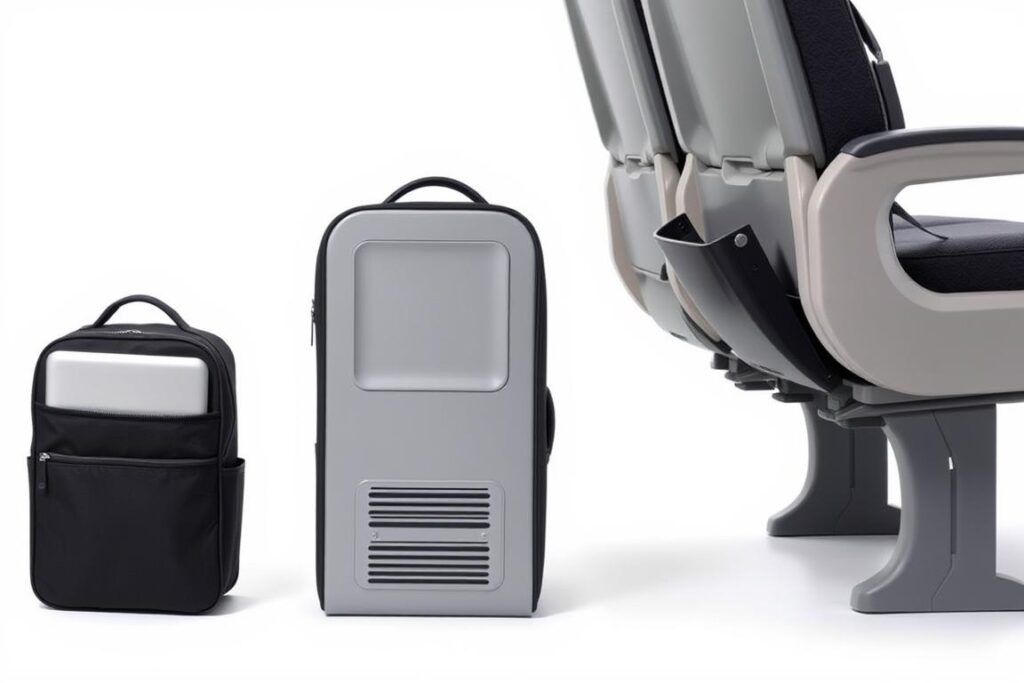
Personal Item Bags
These compact bags must fit underneath the seat in front of you on a plane. They include briefcases, small backpacks, large purses, and specially designed underseat bags. Ideal for essentials you need during your flight.
Typical dimensions: 18×14×8 inches for domestic flights, though requirements vary by airline.
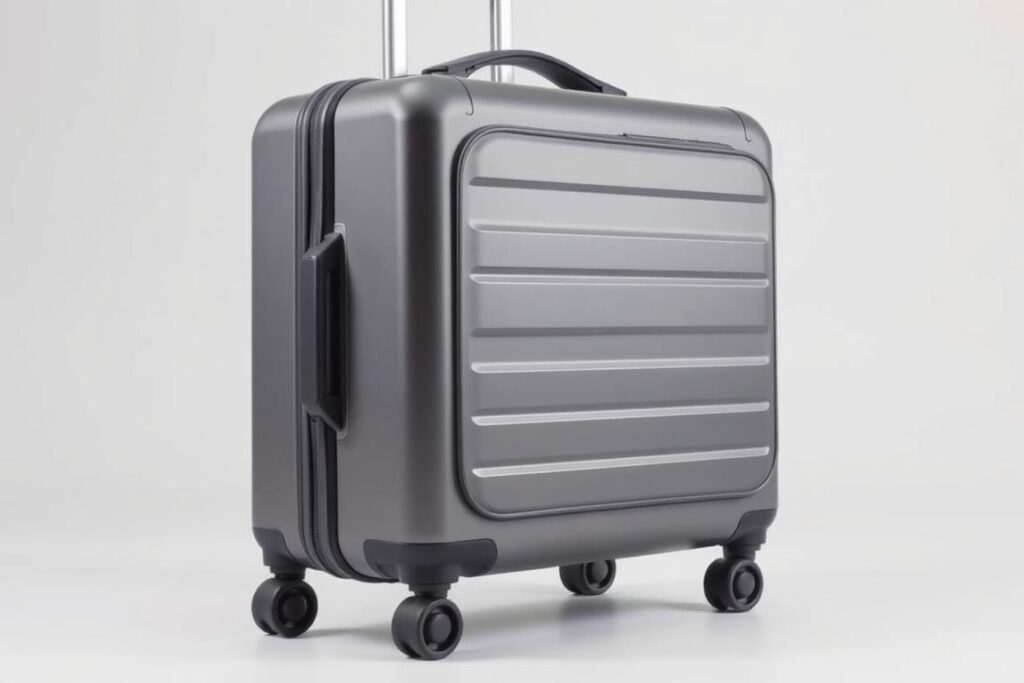
Carry-On Luggage
These bags are designed to fit in the overhead compartment of an airplane. They’re perfect for short trips or as a complement to checked luggage for longer journeys.
Typical dimensions: 22×14×9 inches for domestic flights, though international carriers often have stricter size limits.
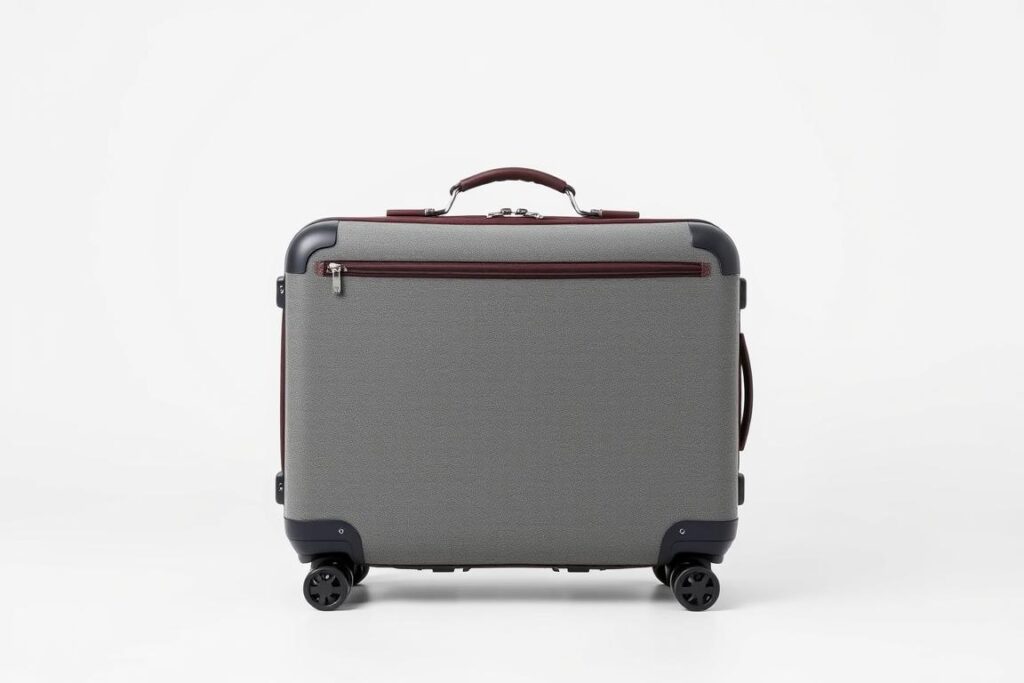
Checked Luggage
These larger suitcases must be checked with the airline before boarding. They provide ample space for longer trips but come with weight restrictions and potential fees.
Common sizes: 24-30 inches in height, with weight limits typically around 50 pounds.
Pro Tip: Many airlines now charge for carry-on bags, especially budget carriers like Frontier and Spirit. Always check your airline’s specific baggage policy before packing.
Choosing the Right Luggage Size
Selecting the appropriate size for your suitcase is crucial to avoid airline fees and ensure you have enough space for your belongings.
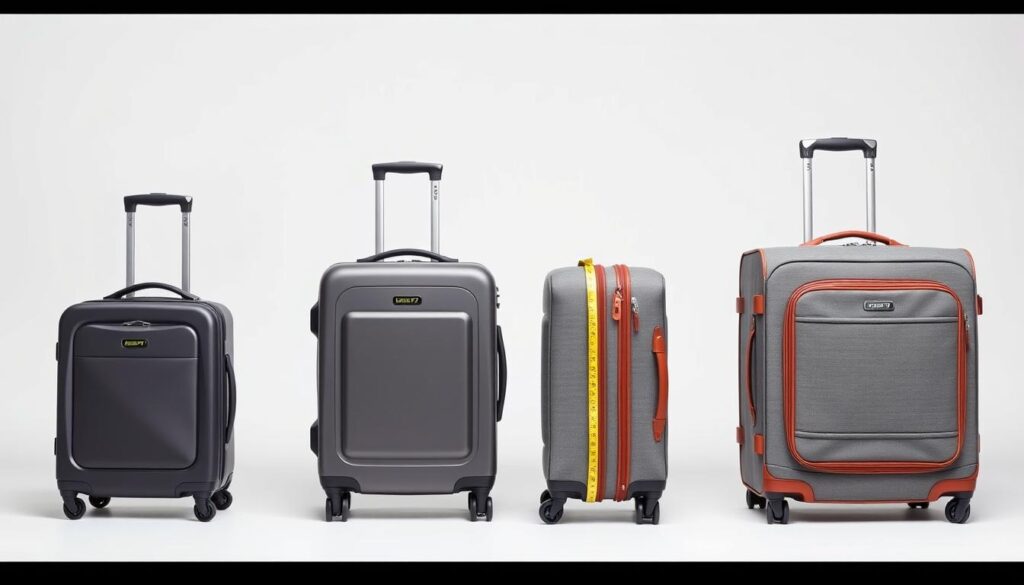
Airline Size Restrictions
Airlines have specific size limitations for both carry-on and checked luggage. For domestic flights on major airlines, the standard size for carry-on bags is typically 22×14×9 inches. International flights often have smaller size limits. Always measure the height from the floor to the top of the handle in its lowered position, including wheels.
| Trip Length | Recommended Size | Typical Capacity | Best For |
| 1-3 days | Personal item or small carry-on | 25-35 liters | Weekend getaways, business trips |
| 3-5 days | Carry-on (21-22 inches) | 35-45 liters | Extended weekends, short business trips |
| 1-2 weeks | Medium checked (24-26 inches) | 60-75 liters | Vacations, longer business trips |
| 2+ weeks | Large checked (28-32 inches) | 80-120 liters | Extended vacations, international travel |
Baggage Fees and Weight Limits
Most major airlines charge for checked bags on domestic flights, typically $30-40 for the first bag and more for additional bags. Budget airlines may also charge for carry-ons. Weight limits for checked bags usually range from 50-70 pounds, with overweight fees being quite steep. Consider investing in luggage scales to avoid surprises at the airport.
Remember that the lighter your empty suitcase, the more clothing and souvenirs you can pack without exceeding weight limits. Look for lightweight options that don’t sacrifice durability.
Hard-Shell vs. Soft-Sided Luggage
The material of your suitcase affects its durability, weight, and functionality. Both hard-shell and soft-sided options have distinct advantages and drawbacks.
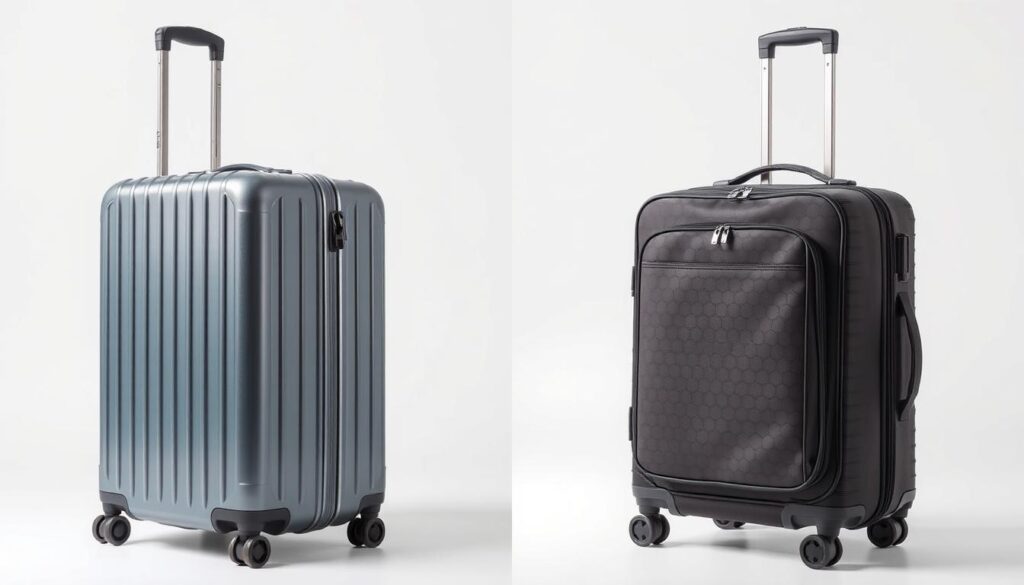
Hard-Shell Luggage
Pros:
- Better protection for fragile items
- More water-resistant
- Easier to clean
- Improved security with integrated locks
- Stacks well (ideal for cruise ships)
- Prevents overpacking
Cons:
- Can scuff and scratch easily
- Less flexible for fitting into tight spaces
- Fewer external pockets
- Requires double the surface space to open fully
- Can be heavier (though modern materials are improving)
Materials: Polycarbonate (durable but heavier), ABS plastic (lighter but less durable), aluminum (most durable but heaviest)
Soft-Sided Luggage
Pros:
- Generally lighter weight
- More flexible for fitting into tight spaces
- Often expandable for extra capacity
- Multiple external pockets for organization
- Easier to store when not in use
- Can squeeze in extra items if needed
Cons:
- Less protection for fragile contents
- More vulnerable to ripping
- Less water-resistant
- Can get dirty more easily
- External pockets may not be secure
Materials: Ballistic nylon (durable with a shiny finish), Cordura nylon (softer and abrasion-resistant), ripstop nylon (lightweight but should be high-denier for durability)
“The best luggage material depends on your priorities. If protection is paramount, go hard-shell. If weight and flexibility matter most, soft-sided is your best bet.”
Wheel Options: Spinners vs. Rollers
The type of wheels on your suitcase significantly impacts how easily you can maneuver through crowded airports and busy streets.
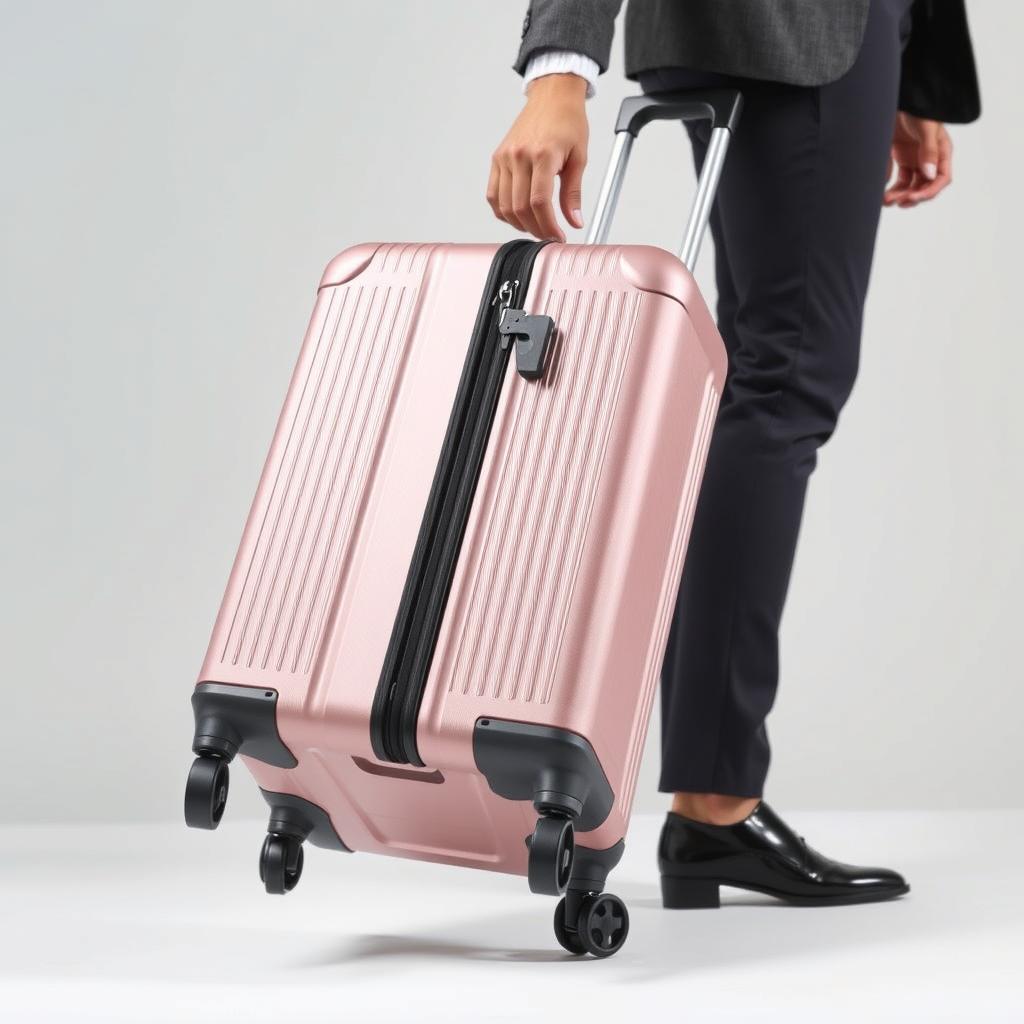
Four-Wheel Spinners
Spinner suitcases have four wheels that each rotate 360 degrees. This design allows for multidirectional movement—you can push, pull, or wheel them alongside yourself.
Advantages:
- Easier to navigate in tight spaces
- Less strain on shoulders and wrists
- Can be pushed upright beside you
- Better for heavier bags as you don’t need to drag the weight
Disadvantages:
- Externally mounted wheels are more vulnerable to damage
- Won’t stay in place on inclines
- Take up more of your allowed dimensions
- Less effective on uneven surfaces
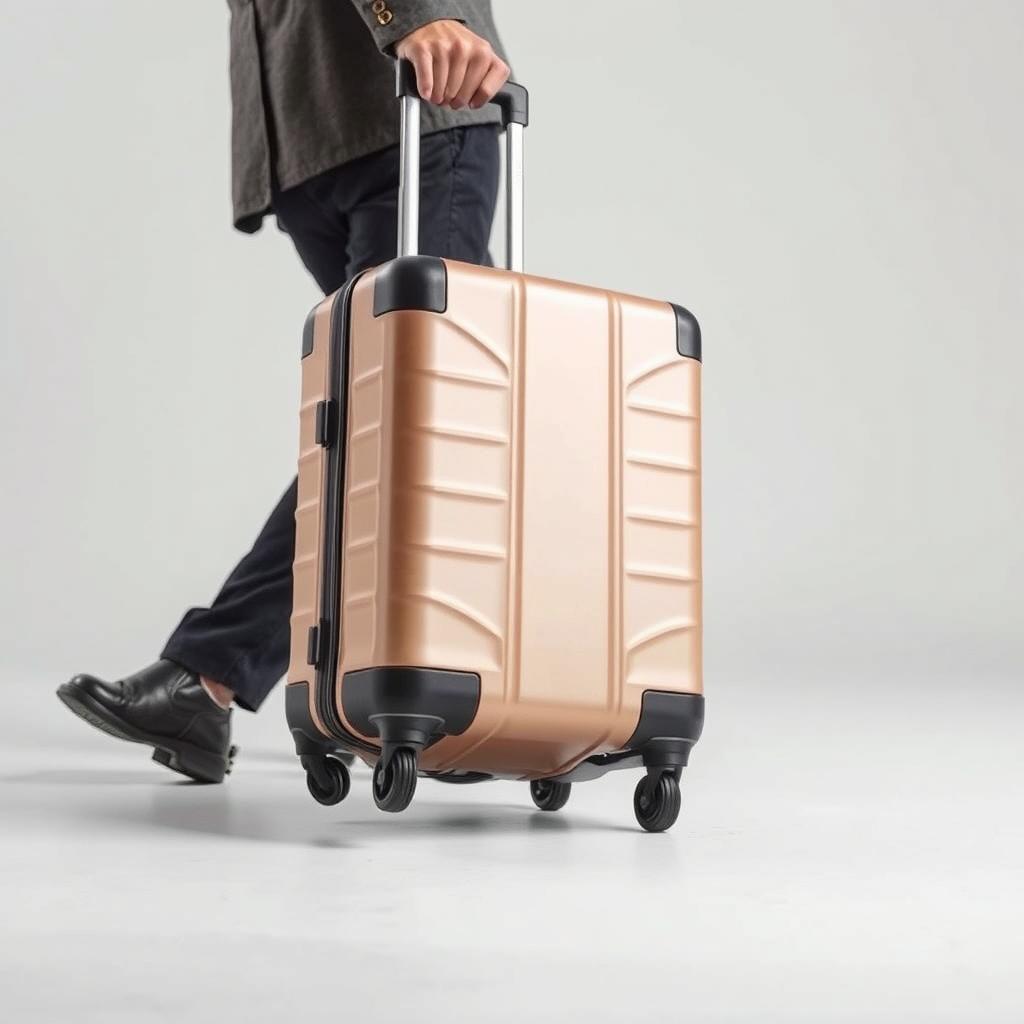
Two-Wheel Rollers
Two-wheeled suitcases, also called rollers, use in-line skate-style wheels that only move forward and backward. The suitcase is pulled behind you at an angle.
Advantages:
- Recessed wheels are better protected
- More stable on uneven surfaces
- Better for clearing curbs and obstacles
- Wheels don’t count as much toward size limits
Disadvantages:
- Can cause strain on shoulders and wrists
- Less maneuverable in crowded spaces
- Recessed wheels take up interior packing space
- Must be dragged rather than pushed
Best Choice: For city travel with uneven sidewalks and curbs, two-wheel rollers perform better. For airport-to-hotel travelers who navigate mostly smooth surfaces, four-wheel spinners offer superior maneuverability.
Essential Features to Consider
Beyond the basic type, size, material, and wheels, several other features can make a significant difference in your travel experience.
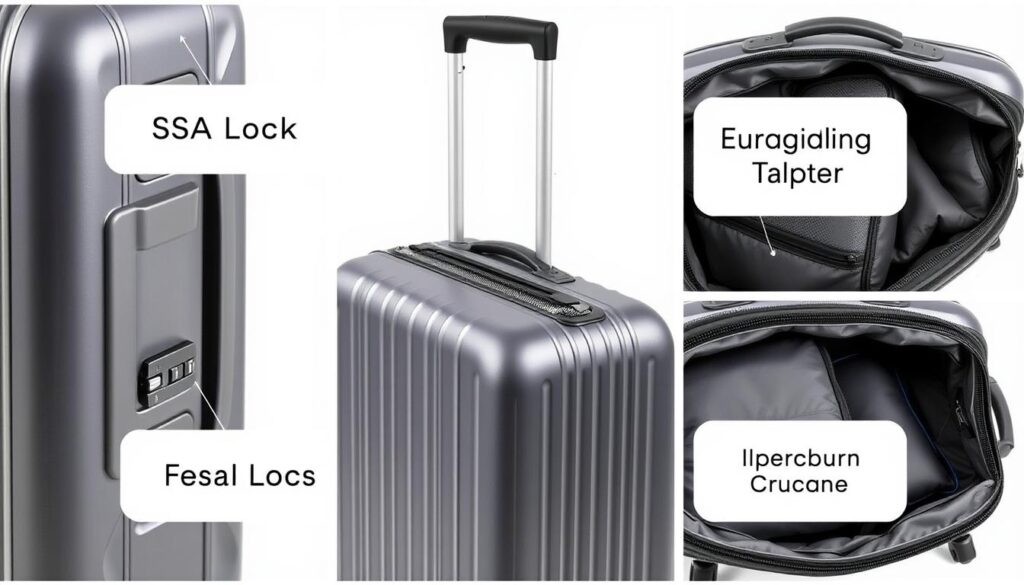
Handles
Look for telescoping handles that retract completely inside the bag to prevent damage. Adjustable-length handles with soft grips provide maximum comfort. Two-post handles are generally more stable than single-post designs and can support additional items like a laptop bag.
Side and top handles are essential for lifting your bag onto scales, into overhead bins, or off baggage carousels.
Zippers
Quality zippers are crucial—they’re often the first part of a suitcase to fail. Chain zippers with interlocking metal teeth are stronger and more secure than coil zippers. YKK zippers are widely considered the most reliable in the industry.
Water-resistant zippers provide additional protection for your belongings in rainy conditions.
Locks
For U.S. travel, choose TSA-compliant locks that security agents can open with a universal master key if they need to inspect your bag. This prevents them from breaking your lock during random checks.
Integrated locks offer convenience, while separate locks provide flexibility across different bags.
Compartments
Interior organization features like mesh pockets, compression straps, and dividers help keep your belongings neat and accessible. Some suitcases include dedicated laptop compartments or suiter sections for wrinkle-free garment transport.
External pockets on soft-sided luggage provide quick access to items but remember they count toward your overall dimensions.
Expandability
Expandable suitcases offer additional packing space (typically 15-25% more) via a zippered section that increases the bag’s depth. This feature is perfect for bringing home souvenirs or accommodating last-minute additions.
Note that expanded carry-ons may exceed airline size restrictions and need to be checked.
Weight
Lightweight luggage helps you maximize your packing capacity within airline weight restrictions. Experts recommend that non-wheeled bags weigh between 2-4 pounds empty, while wheeled bags should ideally weigh no more than 7.5 pounds.
Remember that ultra-lightweight options sometimes sacrifice durability.
Smart Luggage Features
Modern suitcases increasingly incorporate technology to enhance the travel experience. These “smart” features can add convenience but come with considerations.
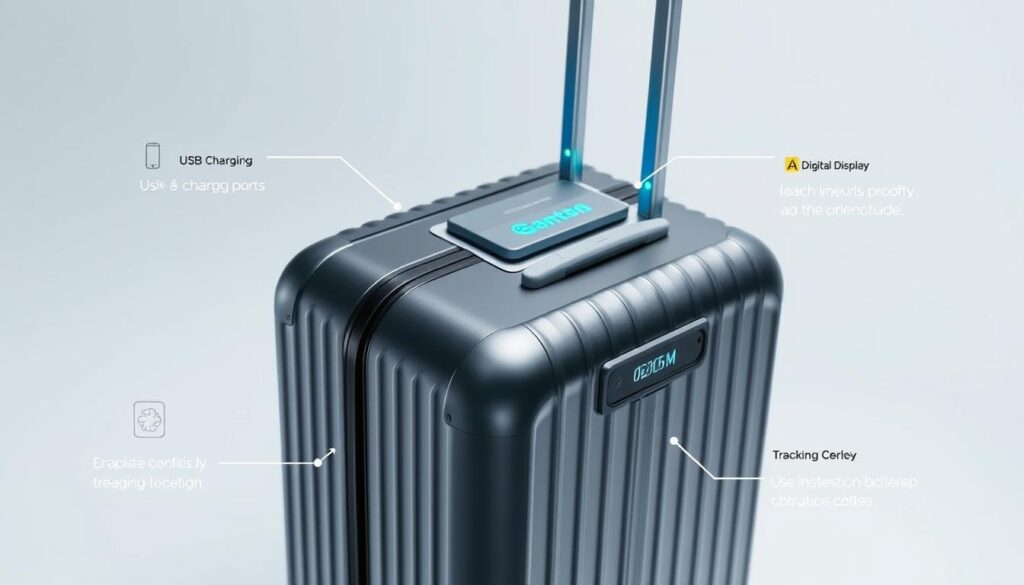
Popular Smart Features
- USB charging ports: Allow you to charge devices on the go
- GPS tracking: Helps locate lost luggage
- Digital scales: Let you weigh your bag without additional tools
- Bluetooth/proximity sensors: Alert you if you leave your bag behind
- Digital locks: Offer keyless security, sometimes with fingerprint recognition
- Battery packs: Power the smart features and your devices
Important: Airlines and the TSA have strict regulations regarding batteries in luggage. Lithium-ion batteries must be removable and carried in the cabin, not checked. Always check current regulations before traveling with smart luggage.
While these features can be convenient, they add weight and cost to your luggage. Consider whether the benefits justify these trade-offs for your travel style.
Durability and Warranty Considerations
A suitcase is an investment that should last for many trips. Understanding durability factors and warranty terms helps ensure you get good value for your money.
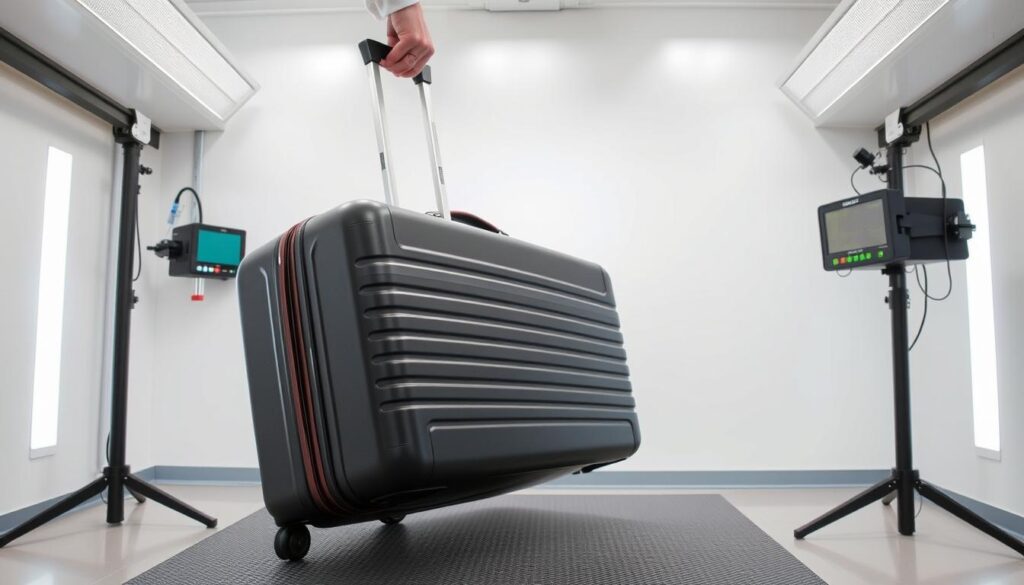
Assessing Durability
When examining a potential suitcase purchase, test these elements:
- Handle stability: Check for minimal wiggling or rattling when extended
- Wheel attachment: Gently jiggle the wheels to ensure they’re firmly secured
- Zipper quality: Look for smooth movement and sturdy construction
- Corner protection: Reinforced corners resist damage during handling
- Seam strength: Examine stitching quality, especially at stress points
Understanding Warranties
Warranty terms vary significantly between manufacturers and can indicate their confidence in their products:
- Lifetime warranties: Brands like Briggs & Riley offer comprehensive lifetime repair policies
- Limited lifetime warranties: Cover specific components or exclude certain types of damage
- Trial periods: Some brands like Away offer “test drive” periods of up to 100 days
- Airline damage: Check if the warranty covers damage caused during airline handling
“The quality of a warranty often reflects the quality of the product. Manufacturers who stand behind their luggage with comprehensive warranties typically build more durable products.”
Always read the fine print of warranty terms before purchasing, and keep your receipt and warranty information in a safe place.
Budget and Price Considerations
Luggage prices vary dramatically, from budget options under $100 to premium brands exceeding $500. Understanding the relationship between price and value helps you make a wise investment.
| Price Range | What to Expect | Best For | Typical Lifespan |
| $50-100 | Basic functionality, limited durability, fewer features | Occasional travelers, short trips | 1-3 years |
| $100-200 | Better materials, improved durability, more features | Regular travelers, varied trip types | 3-5 years |
| $200-350 | High-quality materials, good warranties, premium features | Frequent travelers seeking reliability | 5-10 years |
| $350+ | Top-tier materials, excellent warranties, innovative features | Business travelers, luxury seekers | 10+ years |
Value Considerations
When evaluating price versus value, consider:
- Travel frequency: More frequent travelers should invest in higher quality
- Trip types: Rough handling (checked bags) requires more durability
- Warranty terms: A lifetime warranty may justify a higher upfront cost
- Weight savings: Lightweight premium materials can help avoid overweight fees
Smart Shopping Tip: Look for last season’s models or sales from reputable brands rather than choosing the cheapest option available. This approach often provides the best balance of quality and value.
Top Suitcase Recommendations
Based on extensive research and consumer reviews, here are some of the best suitcases for different travel needs and budgets.
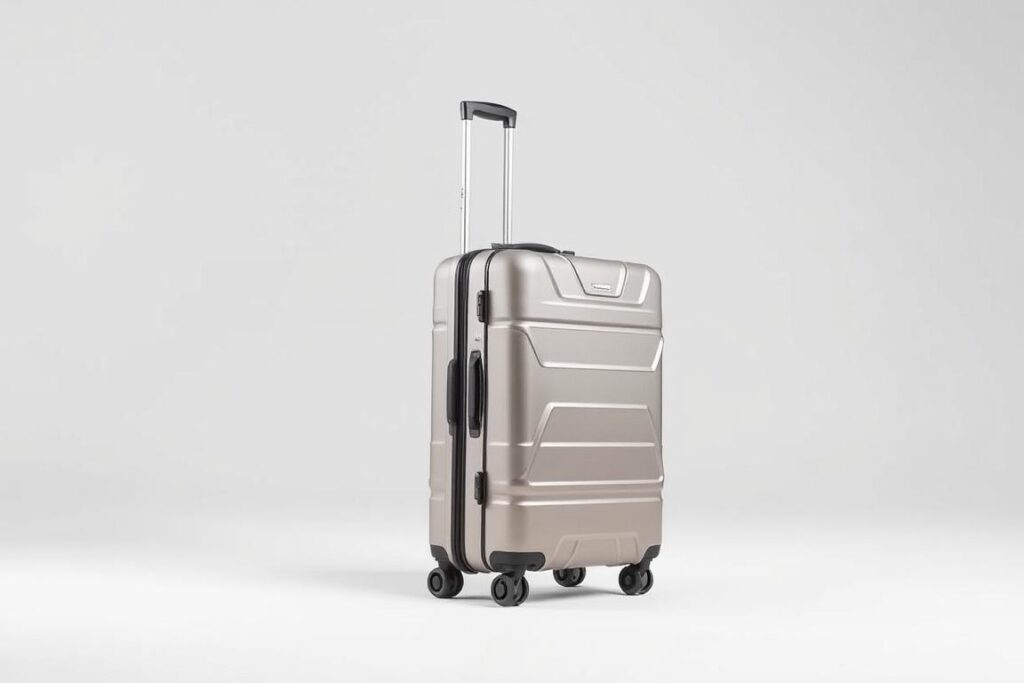
Best Overall Carry-On
Travelpro Maxlite 5 21″ Expandable Spinner
Lightweight yet durable, this soft-sided spinner weighs just 5.4 pounds and meets most domestic carry-on requirements. Features include a telescoping handle, expandable capacity, and water-resistant coating.
Best for: Frequent flyers seeking reliability without excessive weight
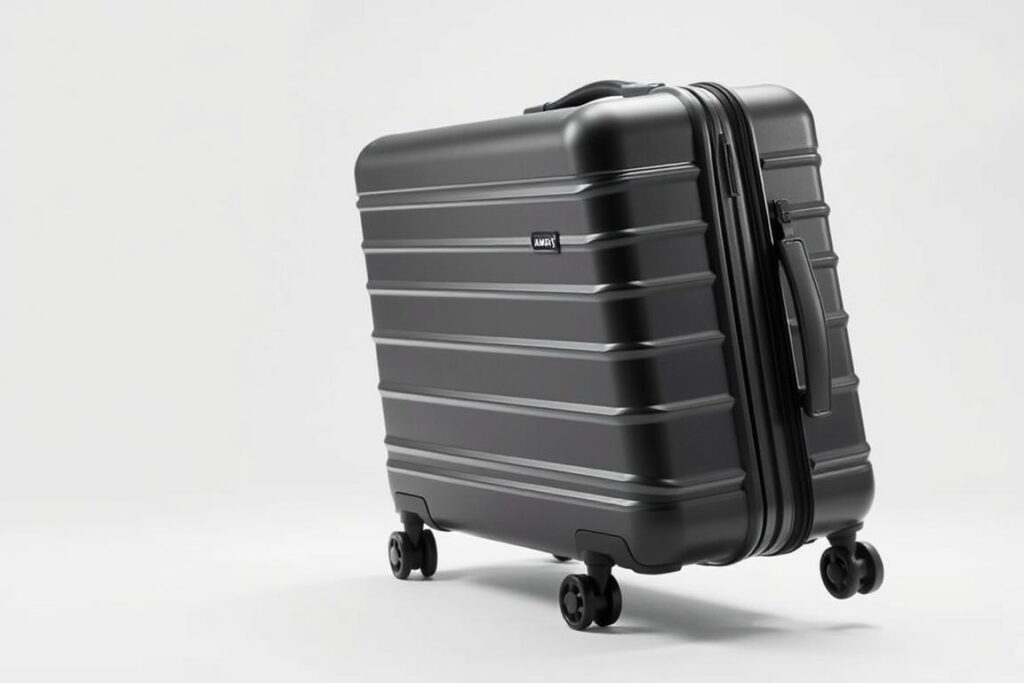
Best Hard-Shell Carry-On
Away The Carry-On
This polycarbonate hard-shell features an optional ejectable battery for charging devices, TSA-approved lock, and 360° spinner wheels. The interior includes a compression system and laundry bag.
Best for: Tech-savvy travelers who appreciate sleek design and organization
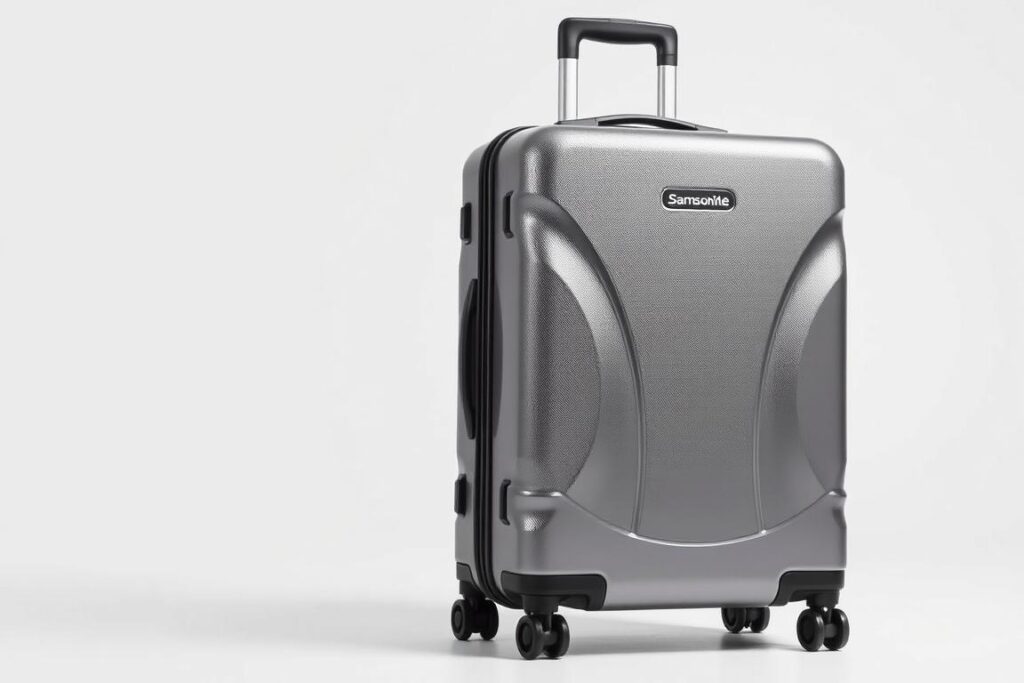
Best Value Checked Luggage
Samsonite Omni PC Hardside 24″
This polycarbonate hard-shell offers excellent scratch resistance with its micro-diamond texture. Features include a TSA lock, spinner wheels, and expandable capacity, all at a reasonable price point.
Best for: Value-conscious travelers needing durable checked luggage
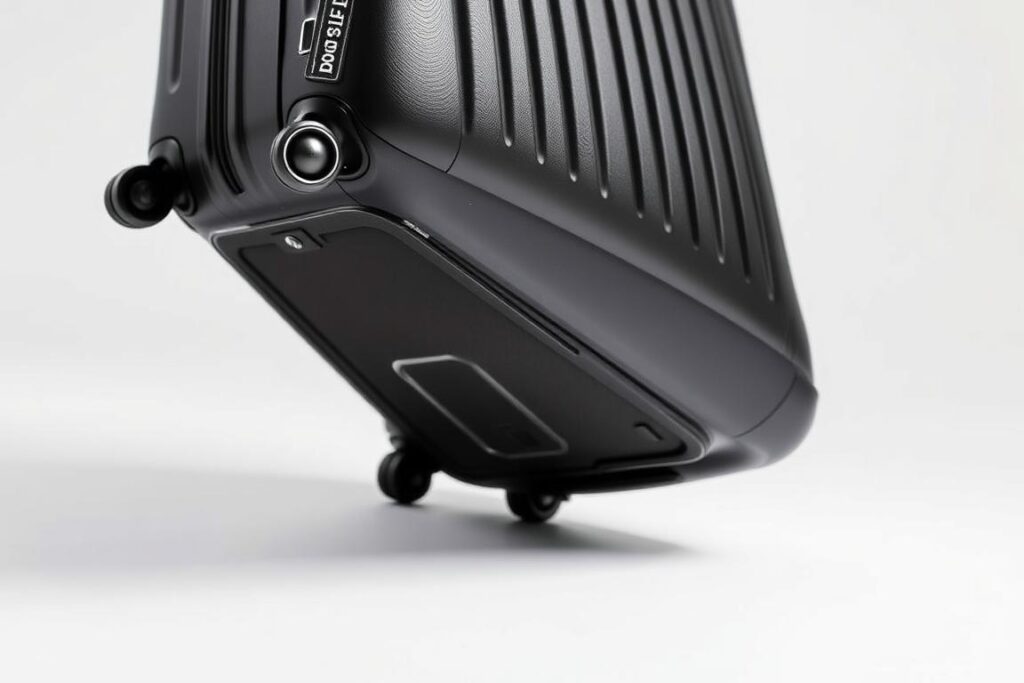
Best Premium Option
Briggs & Riley Baseline Expandable Spinner
Known for its industry-leading lifetime warranty that covers even airline damage, this premium soft-sided spinner features a unique compression-expansion system that increases packing capacity then compresses back to original size.
Best for: Frequent travelers seeking the ultimate in quality and warranty protection
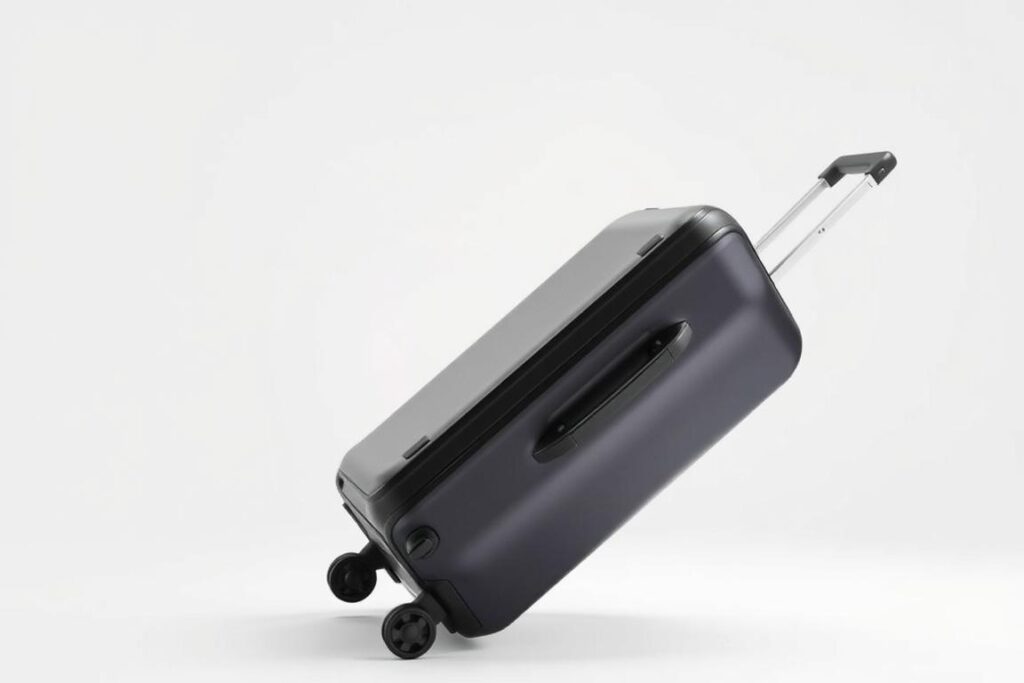
Best Budget Carry-On
Amazon Basics Hardside Spinner
This affordable ABS hard-shell offers basic functionality at a fraction of the price of premium brands. Features include spinner wheels, telescoping handle, and expandable capacity up to 15%.
Best for: Occasional travelers or those on a tight budget
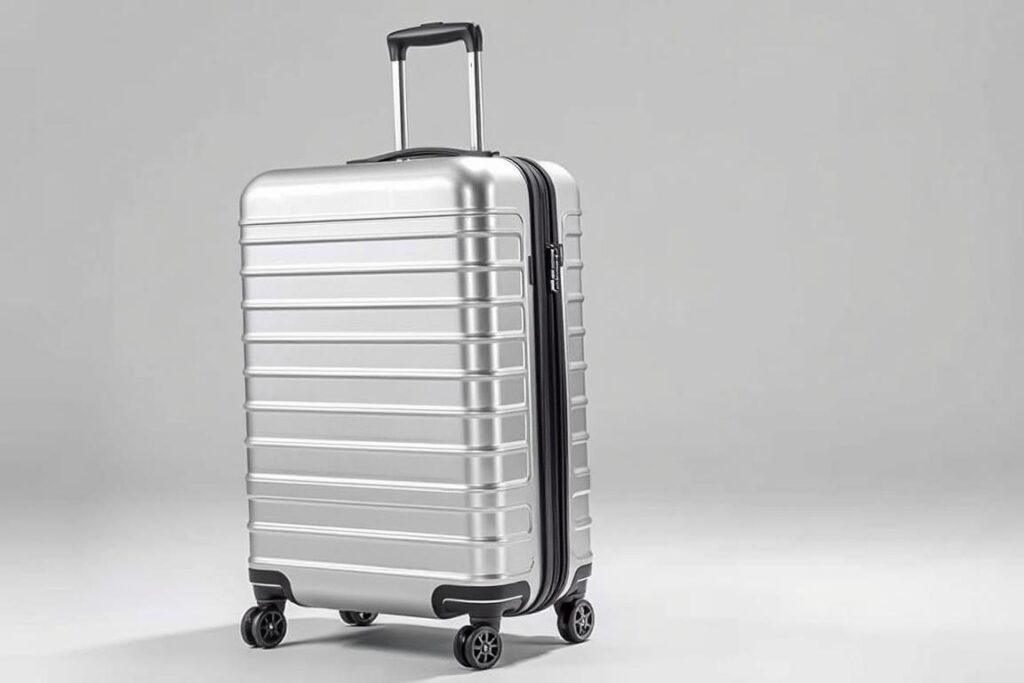
Best for International Travel
Delsey Paris Helium Aero 19″ International
Designed to meet stricter international carry-on requirements, this polycarbonate hard-shell features a front compartment with padded laptop sleeve, making it ideal for business travelers. Includes TSA lock and double spinner wheels.
Best for: International travelers needing a compliant carry-on with business features
Practical Shopping Tips
When you’re ready to purchase your suitcase, these practical tips will help ensure you make the right choice.
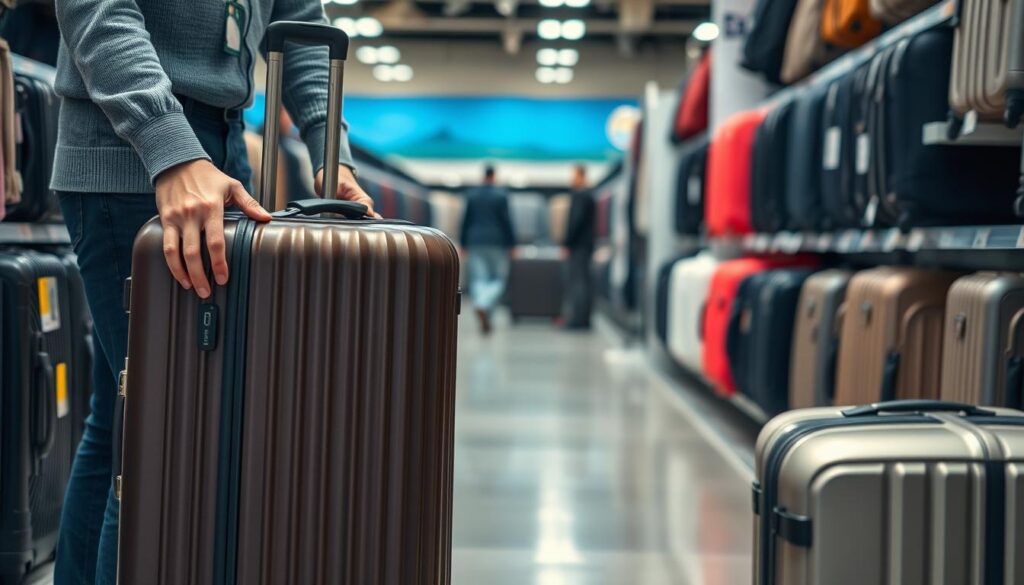
In-Store Testing
- Measure yourself: Don’t trust labels claiming “official carry-on size”—verify dimensions with a tape measure
- Test the handle: Extend and retract it multiple times, checking for smooth operation and minimal wobbling
- Roll it around: Test maneuverability on different surfaces if possible
- Check interior capacity: Open the suitcase fully to assess the usable space and organization features
- Lift it: Make sure the empty weight is manageable for you
Online Shopping
- Read the specifications: Pay close attention to dimensions, weight, and materials
- Check return policies: Ensure you can return the luggage if it doesn’t meet your expectations
- Read user reviews: Look for comments about durability over time, not just initial impressions
- Watch video reviews: These often show features in action better than static images
- Verify warranty details: Understand exactly what is covered and for how long
Timing Tip: Major luggage sales typically occur in March (before spring break travel), late May (before summer vacations), and November (Black Friday/Cyber Monday). Shopping during these periods can save you 30-50% on quality brands.
Frequently Asked Questions
Is hard-shell luggage better than soft-sided?
Neither is universally “better”—it depends on your needs. Hard-shell luggage offers better protection for fragile items and more security, while soft-sided luggage is typically lighter, more flexible for fitting into tight spaces, and often includes external pockets. Consider your travel style and priorities when choosing between them.
What size suitcase do I need for a 10-day trip?
For a 10-day trip, a medium checked suitcase (24-26 inches) is typically sufficient for most travelers. If you’re an efficient packer or traveling to warm climates where clothing is lighter, you might manage with a large carry-on. If you’re traveling in winter or need to pack formal attire, you might prefer a larger 28-inch checked bag.
Are expensive suitcases worth the investment?
For frequent travelers, higher-end luggage often proves worthwhile due to superior durability, better warranties, and improved functionality. The cost per use decreases significantly over time. However, occasional travelers may find mid-range options provide sufficient quality without the premium price. Consider your travel frequency and how long you expect to use the suitcase when deciding your budget.
How can I maximize packing space in my suitcase?
To maximize space, use packing cubes to compress clothing and keep items organized. Roll softer items like t-shirts and underwear, and fold stiffer items like dress shirts. Fill shoes with socks or small items. Use compression bags for bulky items like sweaters or jackets. Pack heavier items at the bottom (wheel end) of the suitcase for better balance.
How do I protect my suitcase during travel?
To protect your investment, consider using a luggage cover for checked bags to prevent scratches and scuffs. Remove old airline tags to prevent routing confusion. Make your bag easily identifiable with a unique luggage tag or colorful strap to reduce the risk of someone else taking it. For hard-shell luggage, store it inside a dust bag when not in use to prevent scratches.
Making Your Final Decision
Choosing the right suitcase for travel is a personal decision that depends on your specific needs, preferences, and budget. By considering the factors we’ve discussed—size, material, wheels, handles, compartments, and special features—you can find luggage that will serve you well for years to come.
Remember that the best suitcase is one that meets your particular travel requirements. A frequent business traveler has different needs than a family vacationer or adventure traveler. Take the time to assess your typical travel patterns and prioritize features accordingly.
Whether you opt for a lightweight spinner carry-on, a durable hard-shell checked bag, or a versatile expandable option, investing in quality luggage is an investment in smoother, more enjoyable travel experiences.
Ready to Find Your Perfect Travel Companion?
Browse our recommended suitcases or share your favorite luggage features and experiences in the comments below!



